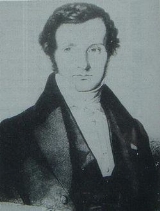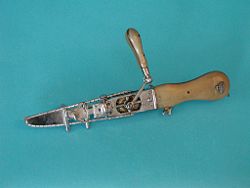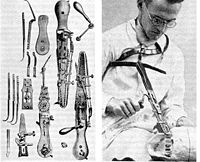
Bernhard Heine
Encyclopedia
Bernhard Heine was a German physician, bone specialist and the inventor of the osteotome
, a medical tool for cutting bones.
in Schramberg. At the age of ten (according to other references, thirteen) years he was apprenticed to his uncle Johann Georg Heine
in Würzburg
as an orthopaedic mechanic. Without any enrolment he later attended lectures in medicine at the University of Würzburg
.
After a number of journeys he took over his own department in his uncle's orthopaedic institute. When Johann Georg moved to Holland in 1829 Bernhard - together with his cousin Joseph Heine
- became the head of the Würzburg institution.
In 1837 Bernhard Heine married his cousin (Johann Georg's daughter) Anna Heine (*1801).
.


Heine declined an offer of the Russian Tsar Nicholas I
to take over the position of an orthopaedic senior consultant at the imperial school in Kronstadt
and returned to Würzburg.
The Würzburg university awarded him an honorary doctorate in 1836 and an honorary professorship in 1838, although he had never acquired any degree.
, the tissue covering the bones, is decisive in bone regeneration and therefore has to be spared violation in the operating process.
Unfortunately his early death did not allow him to publish his findings in a medical work.
Since 1844 he had taught Experimental Physiology at the Würzburg university as an associate professor, but fell ill with tuberculosis
and died on July 31, 1846
on a recreation trip to Switzerland in Glockenthal near Thun.
It was not until 1926, eighty years after his death that his research findings were published (see external link biography).
Osteotome
An osteotome is an instrument used for cutting or preparing bone.The instrument was invented by Bernhard Heine, a German physician in Würzburg, in 1830. Heine's invention was used as a bone saw, especially for opening the skull. It was a kind of chain saw moved by turning a winder.Today osteotomes...
, a medical tool for cutting bones.
Apprenticeship in Würzburg
Bernhard Heine was born on August 20, 1800 as the son of a tannerTanning
Tanning is the making of leather from the skins of animals which does not easily decompose. Traditionally, tanning used tannin, an acidic chemical compound from which the tanning process draws its name . Coloring may occur during tanning...
in Schramberg. At the age of ten (according to other references, thirteen) years he was apprenticed to his uncle Johann Georg Heine
Johann Georg Heine
Johann Georg Heine was a German orthopedic mechanic and physician. He is considered the father of Orthopedics in Germany.- From cutler to orthopedic mechanic :...
in Würzburg
Würzburg
Würzburg is a city in the region of Franconia which lies in the northern tip of Bavaria, Germany. Located at the Main River, it is the capital of the Regierungsbezirk Lower Franconia. The regional dialect is Franconian....
as an orthopaedic mechanic. Without any enrolment he later attended lectures in medicine at the University of Würzburg
University of Würzburg
The University of Würzburg is a university in Würzburg, Germany, founded in 1402. The university is a member of the distinguished Coimbra Group.-Name:...
.
After a number of journeys he took over his own department in his uncle's orthopaedic institute. When Johann Georg moved to Holland in 1829 Bernhard - together with his cousin Joseph Heine
Joseph Heine
Joseph Heine was a German physician and a high civil servant in the Bavarian health service in the Rheinkreis.-Medical career in Franconia and in the Palatinate :...
- became the head of the Würzburg institution.
In 1837 Bernhard Heine married his cousin (Johann Georg's daughter) Anna Heine (*1801).
Inventing the osteotome
In 1830, after long years of research and development, Bernhard Heine presented a medical tool to his colleagues. It was a "bone saw", which he called osteotome and which revolutionized surgical treatment. His invention was a great success among medical experts all over Europe. Heine travelled to other parts of Germany, France and even Russia to present it to other surgeons. In 1836 already a doctoral thesis on the "Osteotome and its application" was published in MunichMunich
Munich The city's motto is "" . Before 2006, it was "Weltstadt mit Herz" . Its native name, , is derived from the Old High German Munichen, meaning "by the monks' place". The city's name derives from the monks of the Benedictine order who founded the city; hence the monk depicted on the city's coat...
.


| left: the osteotome | right: its various parts and its usage |
|---|
Heine declined an offer of the Russian Tsar Nicholas I
Nicholas I of Russia
Nicholas I , was the Emperor of Russia from 1825 until 1855, known as one of the most reactionary of the Russian monarchs. On the eve of his death, the Russian Empire reached its historical zenith spanning over 20 million square kilometers...
to take over the position of an orthopaedic senior consultant at the imperial school in Kronstadt
Kronstadt
Kronstadt , also spelled Kronshtadt, Cronstadt |crown]]" and Stadt for "city"); is a municipal town in Kronshtadtsky District of the federal city of St. Petersburg, Russia, located on Kotlin Island, west of Saint Petersburg proper near the head of the Gulf of Finland. Population: It is also...
and returned to Würzburg.
The Würzburg university awarded him an honorary doctorate in 1836 and an honorary professorship in 1838, although he had never acquired any degree.
Research work on bone formation
Bernhard Heine acquired valuable knowledge in the field of bone formation and bone regeneration, which is still valid today. He was able to prove that the periosteumPeriosteum
Periosteum is a membrane that lines the outer surface of all bones, except at the joints of long bones. Endosteum lines the inner surface of all bones....
, the tissue covering the bones, is decisive in bone regeneration and therefore has to be spared violation in the operating process.
Unfortunately his early death did not allow him to publish his findings in a medical work.
Since 1844 he had taught Experimental Physiology at the Würzburg university as an associate professor, but fell ill with tuberculosis
Tuberculosis
Tuberculosis, MTB, or TB is a common, and in many cases lethal, infectious disease caused by various strains of mycobacteria, usually Mycobacterium tuberculosis. Tuberculosis usually attacks the lungs but can also affect other parts of the body...
and died on July 31, 1846
on a recreation trip to Switzerland in Glockenthal near Thun.
It was not until 1926, eighty years after his death that his research findings were published (see external link biography).
External links
- biography with pictures and further references

